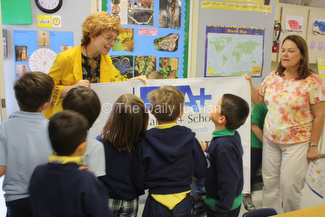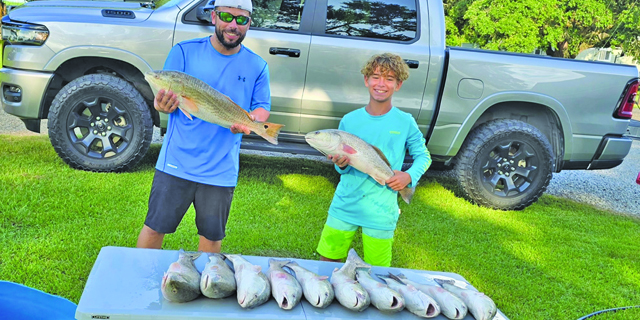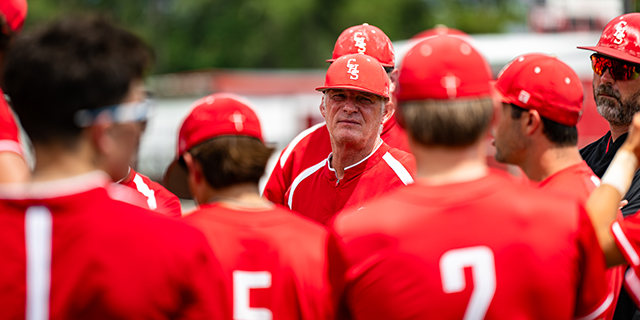A proud A+ school
Published 2:00 pm Friday, April 26, 2013

- Epiphany Day School Head Kathleen O’Shaughnessy shows kindergarten students the banner awarded to the school for becoming a Louisiana A+ school with the George Rodrigue Foundation.
Students at Epiphany Day School soon will experience an artistic, hands-on learning curriculum in every class following the recent announcement that the campus now is considered a Louisiana A+ school.
Trending
The school is among the first seven schools in the state to be accepted into the Louisiana A+ Schools network by the George Rodrigue Foundation of the Arts, a New Orleans based nonprofit group established by the New Iberia native and creator of the Louisiana icon “Blue Dog.”
Epiphany Day School will have a three-year contract with the foundation that will allow the teachers and the administration to take part in professional development, Epiphany Day School Head Kathleen O’Shaughnessy said.
Teachers, artists and school administrators from the foundation, known as fellows, will work with the school’s staff throughout the year to ensure the A+ model is being implemented, she said.
Trending
The A+ program, which is used in three other states, focuses on eight essential philosophies concerning what is being taught in schools, O’Shaughnessy said, with the main focus being on using art in all school subjects.
“They want schools to not just teach art for art sake, but to use artful thinking as tools to engage kids with math, English, science and social studies,” she said. “Their goal is to show us that you don’t have to be an artist in order to bring art into your classrooms.”
Kindergarten students were required to create insects out of Play-Doh Thursday with the requirement that they must have the accurate body and appendages, but the colors and designs were optional. O’Shaughnessy said she believes projects such as that create a blend between the art and science worlds.
The A+ model also focuses on doing hands-on and experiential learning to convey concepts and material to children who may not necessarily learn best through pen-and-paper-style teaching, O’Shaughnessy said.
“There are all kinds of ways to find out what kids know besides paper and pencil tests, and they have a lot of strategies for assessments,” she said. “They let us kind of tailor the professional development to what we need for this school and this staff.”
The staff will begin building the curriculum maps and assessing how the teachers teach each of the subjects across all grade levels at the foundation’s five-day summer institute in June. O’Shaughnessy said she looks most forward to having the fellows assist the teachers in planning their curriculum when they lay out where skills build over grade levels to ensure there are not gaps or unnecessary repletion in learning.
“It’s about teaching what you’ve always taught, but it’s about expanding your methodology and having a broader range of strategies because there is not one strategy that works for every kid in your room,” she said.
The partnership with the foundation follows along the school’s partnership with the Acadiana Symphony Orchestra where music is incorporated into the schools, O’Shaughnessy said. The school began utilizing the four-room, 2,500-square-foot century-old Henton Enrichment House as a music and arts area as part of the school’s Arts and Enrichment Program.
“For them to come in and recognize that our commitment to the arts is genuine and that we cared enough about it to establish the Henton House, it was just kind of a natural follow up,” she said.
Students, parents and teachers have expressed excitement about the announcement. Many believe the new aspects of the curriculum will aid teachers and students alike, said kindergarten assistant Jeanne Levy.
“It’s very exciting. The children naturally learn through art and music so to use these mediums and any combination of them opens the road to endless possibilities, to meet each child where they learn the best and to have fun,” she said.
Levy, who will teach kindergarten next year, said incorporating arts into all classrooms allows other students to help with teaching, work with other students and gives them more creative outlets.
“It’s a holistic approach to how children develop, learn and their nature,” she said. “It makes it fun for me as a teacher and when students see that they pick up the attitude and learn. That’s why it’s exciting.”





